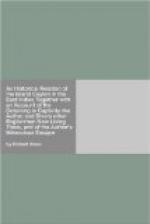of them, like the feathers on each side of a quill.
The Chingulays call the large leaves the boughs, and
the leaves on the sides, the leaves. They fall
off every Year, and the skin upon which they grow,
with them. [The Skins, and their use.] These skins
grow upon the body of the Tree, and the leaves grow
out on them. They also clap about the buds or
blossoms which bear the Nuts, and as the buds swell,
so this skin-cover gives way to them, till at length
it falls quite off with the great leaf on it.
It is somewhat like unto Leather, and of great use
unto the Countrey People. It serves them instead
of Basons to eat their Rice in, and when they go a
Journey to tie up their Provisions: For in these
skins or leaves they can tie up any liquid substance
as Oyl or water, doubling it in the middle, and rowling
it in the two sides, almost like a purse. For
bigness they are according to the Trees, some bigger,
some less, ordinarily they are about two foot length,
and a foot and an half in breadth. In this Countrey
are no Inns to go to, and therefore their manner when
they Travel is, to carry ready dressed what provisions
they can, which they make up in these leaves.
The Trees within have onely a kind of pith, and will
split from one end to the other, the [The Wood.] Wood
is hard and very strong; they use it for Laths for
their Houses, and also for Rails for their Hedges,
which are only stakes struck in the ground, and rails
tyed along with rattans, or other withs growing in
the Woods. [The profit the Fruit yields.] Money is
not very plentiful in this Land, but by means of these
Nuts, which is a great Commodity to carry to the Coasts
of Cormandel, they furnish themselves with all things
they want. The common price of Nuts, when there
was a Trade, as there was when I came first on this
Land, is 20000 for one Doller; but now they ly and
grow, or rot on the ground under the Trees. Some
of these Nuts do differ much from others in their operation,
having this effect, that they will make people drunk
and giddy-headed, and give them some stools, if they
eat them green.
[Jacks.] There is another Fruit, which we call Jacks;
the Inhabitants when they are young call them Polos,
before they be full ripe Cose; and when ripe, Warracha
or Vellas; But with this difference, the Warracha
is hard, but the Vellas as soft as pap, both looking
alike to the eye no difference; but they are distinct
Trees. These are a great help to the People,
and a great part of their Food. They grow upon
a large Tree, the Fruit is as big as a good Peck loaf,
the outside prickly like an Hedg-hog, and of a greenish
colour; there are in them Seeds or Kernels, or Eggs
as the Chingulayes call them, which lie dispersed
in the Fruit like Seeds in a Cucumber. They usually
gather them before they be full ripe, boreing an hole
in them, and feeling of the Kernel, they know if they
be ripe enough for their purpose. Then being cut
in pieces they boil them, and eat to save Rice and
fill their Bellies; they eat them as we would do Turnips




